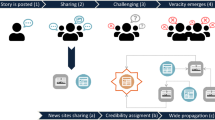Abstract
This article presents details, obtained through the Freedom of Information Act, of an extensive investigation carried out by the Federal Bureau of Investigation into the background and activities of Talcott Parsons. In 1952, following allegations that Parsons was the leader of a Communist Party cell at Harvard University, J. Edgar Hoover authorized a security-type investigation of Parsons; it continued for two years and was conducted throughout the United States and in at least seven European nations. Parsons was eventually cleared of all accusations, but FBI scrutiny of his activities continued on an intermittent basis for at least another thirteen years. Possible influences on Parsons’ scholarship and implications for the sociology of knowledge are also discussed.
Similar content being viewed by others
References
Diamond, Sigmund. 1992.Compromised Campus: The Collaboration of Universities with the Intelligence Community, 1945–1955. New York: Oxford University Press.
Federal Bureau of Investigation. “Talcott Parsons.” File Headquarters 100-390459. Washington, D.C.: FBI Freedom of Information-Privacy Acts Section.
Federal Bureau of Investigation. “Talcott Parsons.” File Headquarters 138-2572. Washington, D.C.: FBI Freedom of Information-Privacy Acts Section.
Gerhardt, Uta (ed.). 1993.Talcott Parsons on National Socialism. New York: Aldine de Gruyter.
Gould, Mark. 1981. “Parsons versus Marx: ‘An earnest warning …’”Sociological Inquiry 51(3–4):197–218.
—————. 1991. “The Structure of Social Action: At Least Sixty Years Ahead of Its Time.” Pp. 85–107 inTalcott Parsons: Theorist of Modernity, edited by R. Robertson and B. Turner. London: Sage Publications.
Hamilton, Peter. 1983.Talcott Parsons. New York: Tavistock and Ellis Horwood Limited.
Johnston, Barry. 1986. “Sorokin and Parsons at Harvard: Institutional Conflict and the Rise of the Hegemonic Tradition.”Journal of the History of Behavioral Sciences 22:107–127.
Keen, Mike Forrest. 1992. “The FBI and American Sociology.”Footnotes 20(May):14.
—————. 1993. “The Freedom of Information Act and Sociological Research.” The American Sociologist 23(2):43–51.
Kuhn, Thomas S. 1970.The Structure of Scientific Revolutions, 2nd edition. Chicago: University of Chicago Press.
Martel, Martin. 1979. “Talcott Parsons.” Pp. 609–630 inInternational Encyclopedia of Social Sciences, vol. 18, edited by David L. Sills, New York: Free Press.
Merton, Robert King. 1949,Social Theory and Social Structure: Toward the Codification of Theory and Research. Glencoe, IL: Free Press.
Nielsen, Jens Kaalhauge. 1991. “The Political Orientation of Talcott Parsons: The Second World War and Its Aftermath.” Pp. 215–233 inTalcott Parsons: Theorist of Modernity, edited by R. Robertson and B. Turner. London: Sage Publications.
Parsons, Talcott. 1954. “‘McCarthyism’ and American Social Tension: A Sociologist’s View.”The Yale Review 44:226–245.
—————. 1977. “On Building Social System Theory: A Personal History.” Pp. 22–76 inSocial Systems and the Evolution of Action Theory. New York: Free Press.
Pitts, Jesse R. 1980. “Talcott Parsons: The Sociologist as the Last Puritan.”The American Sociologist 15:62–64.
Schrecker, Ellen W. 1986.No Ivory Tower: McCarthyism and the Universities. New York: Oxford University Press.
Stouffer, Samuel Andrew. 1955.Communism, Conformity, Civil Liberties: A Cross-section of the Nation Speaks its Mind. Garden City, NY: Doubleday.
Turner, Bryan S. and Roland Robertson. 1991.Talcott Parsons: Theorist of Modernity. London: Sage Publications.
Wiener, Jon. 1989. “Bringing Nazis to the U.S.: Talcott Parsons’ Role.”The Nation 248:289, 306–309.
Williams, Robin Jr. 1980. “Talcott Parsons: The Stereotypes and the Realities.”The American Sociologist 15:64–66.
Author information
Authors and Affiliations
Rights and permissions
About this article
Cite this article
Keen, M.F. No one above suspicion: Talcott parsons under surveillance. Am Soc 24, 37–54 (1993). https://doi.org/10.1007/BF02691918
Issue Date:
DOI: https://doi.org/10.1007/BF02691918



